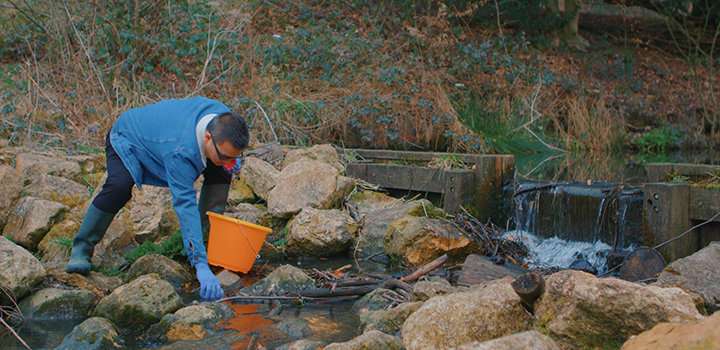New 'eDNA' method to help monitor UK aquatic diversity

A new method of DNA analysis to help monitor the diversity of UK waters, which could help conserve endangered species, has been pioneered by scientists from the University of East Anglia (UEA).
NatureMetrics, a spin-out company from UEA, has announced the launch of innovative "environmental DNA" or "eDNA" fish monitoring, which identifies whole communities of fish from ponds, lakes, streams, rivers, estuaries and oceans.
Traditionally, in order to survey waterways, scientists would need to catch the animals themselves. With this new technique, DNA amplification and sequencing can be used to identify which animals have been present in an area of water, all in one test.
The method, could assess the impact of hydropower plants and other barriers on the passage of migratory fish, including threatened species like eels. The arrival and spread of invasive species, which can threaten native species can also be monitored.
Believed to be the first commercial service of its kind in the UK, the techniques are cheaper and less invasive than traditional methods of surveying fish, such as gillnetting or electrofishing, and usually detect more species.
The company has worked closely with leading academic research groups and environmental policy makers over the last two years to develop, test and refine the methods. They have successfully employed them to monitor fish in UK and international waters, including lakes, rivers and oceans. In one case, just 300 ml of water collected from the Devonshire coast revealed the presence of 25 different species of fish. In another case, working in partnership with Swedish company AquaBiota, the presence of a narwhal was detected in a sample from the Arctic Ocean.
Company founders include leading scientists Prof Douglas Yu, from UEA's School of Biological Sciences, and Prof Alfried Vogler, from Imperial College London.
Prof Yu said: "Our technology means that clients can collect a simple water sample and test it to see whether it contains traces of DNA from particular species.
"Every fish sheds DNA, and even small fragments of that DNA can be used to identify species back in the lab so the fish themselves don't have to be seen to be detected.
"This process is quicker, cheaper and more accurate than traditional methods of monitoring biodiversity." he added.
The technique has applications for businesses, local authorities and conservation groups. Kat Bruce, Co-Founder and MD at NatureMetrics, said: "The method allows anyone to conduct a fish survey to discover what species are present in the area without having to capture or disturb them. And we often detect other non-fish species at the same time – our eDNA bycatch has included everything from newts to narwhals.
"We're excited to launch it to help give our clients better information on species and diversity and in turn to better inform their environmental management decisions."
In one of their early projects, NatureMetrics worked with Norfolk-based consultancy Combined Ecology Ltd to survey river fish in Sierra Leone. Analysing the water samples revealed 54 species of fish, of which 60% could be identified to species.
Dr Phil Atkinson from Combined Ecology said: "We're excited to see this come to the fore after months of innovation and hard work from the NatureMetrics team, and are very glad that Combined Ecology has been part of that journey. We often work in remote and challenging but highly biodiverse environments where this scale and quality of information has just not been accessible before – eDNA will be a game changer."
The fish surveys build on Nature Metrics' existing DNA-based monitoring, including detection of Great Crested Newts and other amphibians, wildlife disease monitoring, invasive species surveillance, and large-scale monitoring of invertebrate communities, which can help to give powerful data on ecosystem health.
Provided by University of East Anglia





















